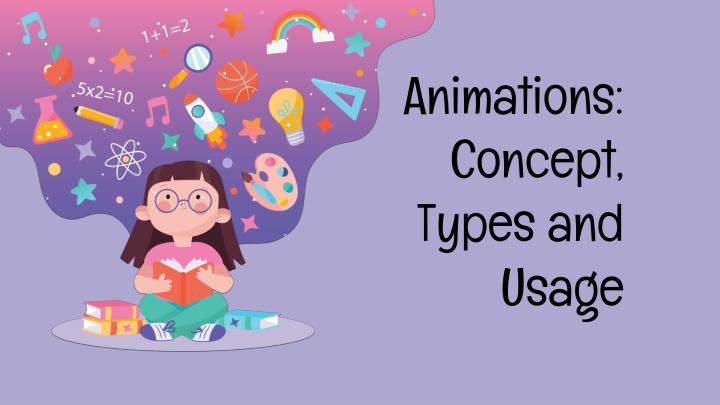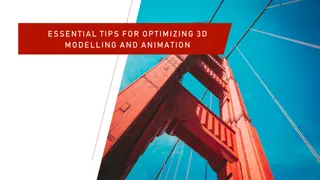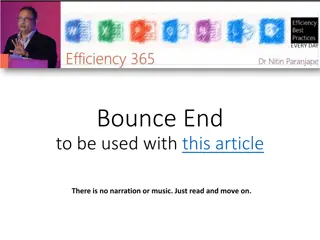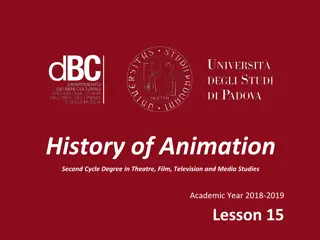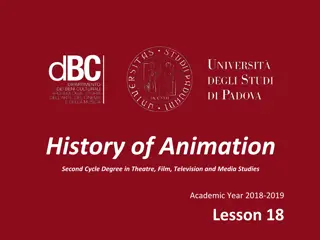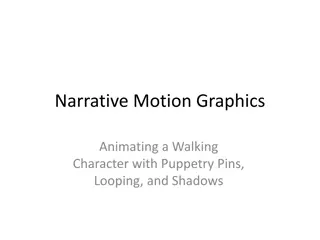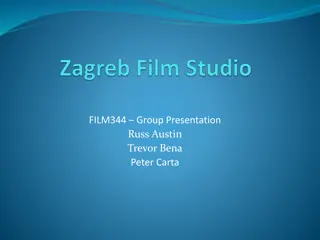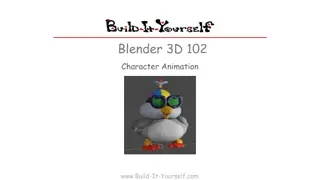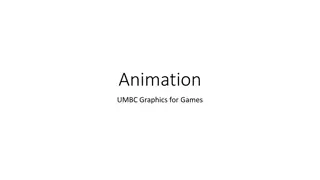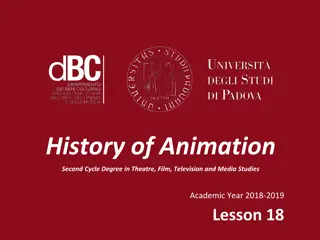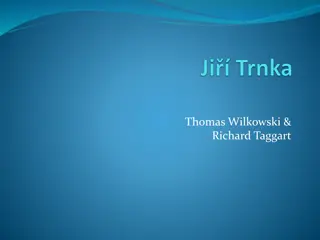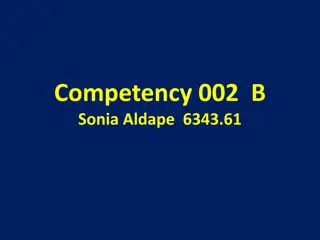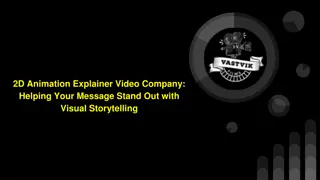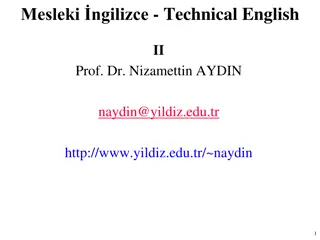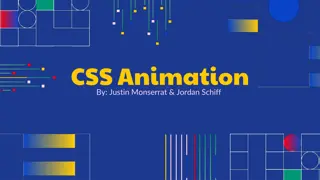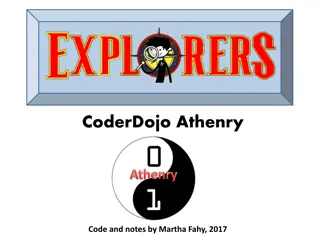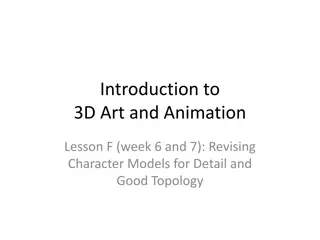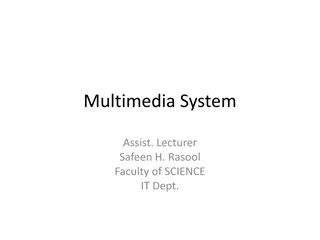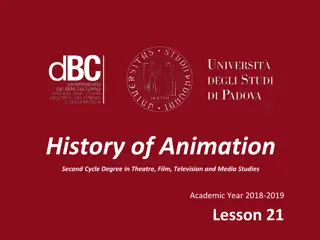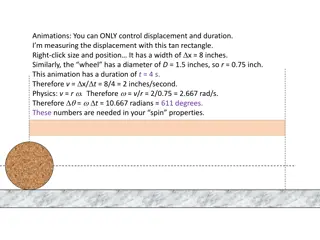Concepts and Types of Animation
Animation is the art of creating the illusion of movement through a sequence of images or frames. It involves arranging pictures in a specific order to simulate motion. Animation includes a variety of forms like cartoons, graphics, moving pictures, and GIFs. Its uses span across advertisement, entertainment, gaming, scientific simulations, and education. Utilizing animations in teaching enhances learning by catering to different learning styles, making it enjoyable, promoting creativity, and improving retention. Despite its benefits, animation also poses challenges due to the effort, time, technical knowledge, and cost involved.
Download Presentation

Please find below an Image/Link to download the presentation.
The content on the website is provided AS IS for your information and personal use only. It may not be sold, licensed, or shared on other websites without obtaining consent from the author.If you encounter any issues during the download, it is possible that the publisher has removed the file from their server.
You are allowed to download the files provided on this website for personal or commercial use, subject to the condition that they are used lawfully. All files are the property of their respective owners.
The content on the website is provided AS IS for your information and personal use only. It may not be sold, licensed, or shared on other websites without obtaining consent from the author.
E N D
Presentation Transcript
Animations: Concept, Types and Usage
What is Animation?
Animation is the process of creating the illusion of movement by displaying a sequence of images, drawings, or frames that change slightly from one to the next
The above bouncing ball animation consists of these six frames, repeated indefinitely.
It is a process in which the pictures are arranged in a specific sequence that creates an illusion of motion of the object.
WHAT ALL DOES ANIMATION INCLUDES ? Cartoons Graphics Moving Pictures GIF
Uses of Animation Advertisement Entertainment Gaming Scientific Simulations Education visualization
Benefits of using Animations in Teaching and Learning Caters to Different Learning Styles Makes Learning Enjoyable Promotes Creativity Imagination Improves Communication Ideas Enhances Complex Concepts Increases Attention Improves Retention and Recall Encourages Active Learning Supports Inclusive Education Understanding of Fun and Engagement and and of
Advantages Makes learning Makes learning Motivates curiosity among Motivates curiosity among faster faster children children Attempt risk Attempt risk- -free free Improve Improve experiments in a safe experiments in a safe engagement engagement environment. environment. A different method of A different method of Visualize subjects Visualize subjects teaching to the teaching to the for better for better traditional classroom traditional classroom Understanding Understanding lecture lecture
Challenges Requires a lot of effort and time Technical knowledge know-how Cost-consuming
Types of Animations Traditional Animation Motion Graphics 2D Animation Stop Motion Animation Rotoscope Animation 3D Animation
Traditional Animation Hand-drawn animation: In this classic form, each frame is drawn by hand. It involves drawing on paper or celluloid sheets, which are then photographed and displayed in sequence. Flipbook animation: A simpler version of traditional animation where a series of drawings on different pages create the illusion of motion when flipped through quickly. Examples: Early Disney films like Snow White and The Lion King (original). https://www.youtube.com/watch?v=csI3yilRPcY
2D Animation In this type, computer software is used to create animations with vector graphics. Unlike traditional animation, where each frame is drawn separately, vector-based animation allows the animator to manipulate parts of the character or object. Vector animation is scalable, meaning it can be resized without losing quality.
3D Animation 3D animation involves creating characters and environments in a three-dimensional space using computer software. The animator manipulates the models to move and interact. 3D animation is commonly used in movies, video games, and virtual reality.
Stop Motion Animation In stop-motion, physical objects are photographed one frame at a time, with slight movements between each shot. When played in sequence, the objects appear to move. It requires careful attention to detail as every movement is manually created. There are different types of stop-motion based on the materials used: Claymation: Uses clay models (e.g., Wallace and Gromit). Puppet animation: Uses puppets (e.g., The Nightmare Before Christmas). Cutout animation: Uses flat materials like paper (e.g., South Park in early episodes). Object animation: Uses objects like toys or household items.
Motion Graphics Motion graphics focus on animating graphic elements like text, logos, or abstract shapes. They are typically used for commercials, title sequences, or explainer videos rather than character-driven storytelling. This type of animation often combines elements of graphic design and animation to convey information in a dynamic way Examples: Intro sequences of TV shows or movies, animated infographics, logo animations.
Process of Developing Animation Analysis: Define objectives, audience, and content. Design: Plan the script, storyboard, and animation style. Development: Create and animate the content. Implementation: Deliver the animation to learners. Evaluation: Assess its effectiveness and make improvements.
Analyse In this phase, you identify the goals, objectives, audience, and resources needed for the animation. You also determine how the animation fits into the broader learning context. Key Steps: Identify learning objectives: What is the purpose of the animation? What knowledge or skills should learners gain from it? Understand the target audience: Who will watch the animation (age, learning style, background knowledge)? Assess resources and constraints: What tools, software, budget, and time are available?
Design During this phase, you create a detailed plan or blueprint for the animation. This includes scripting, storyboarding, and selecting the style and tools for the animation. Key Steps: Develop a script: Write a detailed script outlining the narrative, dialogue, and key information for the animation. Ensure it aligns with the learning objectives. Create storyboards: A storyboard is a visual representation of the animation s key scenes and frames. It maps out the sequence of events, character movements, and dialogue. Choose the animation style: Decide whether the animation will be 2D, 3D, motion graphics, or stop-motion, depending on the objectives and audience. Select software and tools: Identify the animation software you will use (e.g., Adobe Animate, Blender, After Effects). Determine the assessment strategy: Decide how you will assess if learners understand the animation's content (e.g., quizzes, interactive questions)
Develop This is where the actual animation is produced based on the design plan. You build the assets (characters, backgrounds, text) and bring the animation to life. Key Steps: Create animation assets: Develop characters, objects, backgrounds, and other visual elements that will appear in the animation. Animate the scenes: Using the chosen animation software, animate the frames or sequences outlined in the storyboard. Add audio elements: Record and integrate voice overs, sound effects, and background music to enhance the animation. Test the animation: Check for timing, pacing, and quality. Ensure the animation conveys the intended message effectively.
Implement In this phase, you deliver the animation to the intended audience. This might involve embedding it into a lesson, uploading it to a platform, or using it in a classroom setting. Key Steps: Deploy the animation: Share the animation on the intended platform, such as a learning management system (LMS), website, or classroom projector. Facilitate interaction: Depending on the setup, provide opportunities for learners to engage with the content. This could include discussions, interactive elements, or quizzes. Provide instructions for use: Ensure that learners or instructors know how to use the animation as part of the learning process.
Evaluate The final phase involves assessing the effectiveness of the animation in achieving the learning objectives. You evaluate both the learners' performance and the quality of the animation itself. Key Steps: Formative evaluation: Collect feedback during development, such as testing with small groups to identify areas for improvement. Summative evaluation: After implementation, evaluate whether the animation helped achieve the learning objectives. This can be done through tests, quizzes, surveys, or direct observation of learner behavior. Revise as necessary: Based on feedback and evaluations, make any adjustments to the animation for future use.
